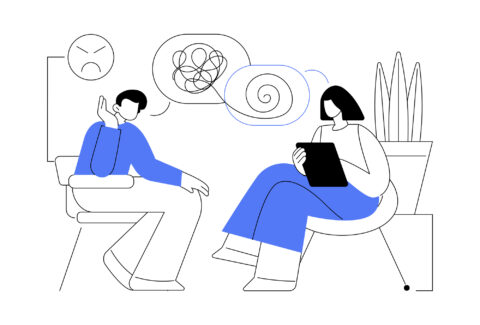When It’s Personal – Countertransference as a Mirror and a Map
“The patient’s unconscious communicates through the therapist’s feelings. If we don’t listen, we miss the message.” — Otto Kernberg
You begin a session feeling neutral. Ten minutes in, your chest is tight, your jaw clenched. Your client is calmly describing their week, but you feel judged, even under attack. By the end, you’re exhausted, irritated, or strangely ashamed; and you don’t know why.
You’ve just experienced countertransference[1].
In Transference-Focused Psychotherapy (TFP), countertransference is not a nuisance to be managed or a distraction to be minimized. It is a clinical tool, a living, breathing expression of the client’s internal world, transmitted directly into your nervous system.
When used wisely, it becomes both a mirror for the client and a map for the therapist.
What Is Countertransference in TFP?
In TFP, countertransference is understood as the total emotional response the therapist has to the patient-conscious and unconscious, subtle, and intense, personal, and archetypal.[2]
Because individuals with identity diffusion often split self and object representations into all-good and all-bad, their internal world is unstable. To manage this, they unconsciously project these representations onto the therapist. The therapist then becomes the container for these intense, unintegrated states.
If we remain unaware of these projections, we may:
- Withdraw emotionally (mirroring the client’s fear of abandonment)
- Become overly nurturing (colluding with their idealization)
- Feel furious and controlling (enacting punitive roles)
- Doubt our competence (internalizing the devaluation)
But if we bring awareness to these reactions, they become data—a rich, real-time window into the client’s relational world.
From Reaction to Reflection
The first step is always awareness.
TFP invites therapists to regularly ask themselves:
- What am I feeling in my body right now?
- What emotion is being stirred that isn’t mine?
- What role am I being cast into—and how am I responding?
This process is not about resisting emotion. It’s about recognizing it, then interpreting it as communication.[3]
For example:
- You feel incompetent → The client may fear they are inherently flawed.
- You feel idealized → The client may be projecting their wish for a perfect caregiver.
- You feel anxious or controlled → The client may be externalizing their fear of being helpless.
The goal is to stay emotionally present without acting out—to feel the impact, contain it, and translate it into therapeutic meaning.
The Therapist’s Stance: Neutrality Without Indifference
In TFP, the therapeutic stance[4] is defined by:
- Neutrality: Not emotionally flat, but not emotionally reactive
- Empathic understanding: Deep awareness of the client’s pain, even when masked by rage or withdrawal
- Technical precision: Knowing when to interpret, when to hold, when to wait
This stance allows the therapist to remain centered even when the room fills with emotional smoke. You are not a rescuer. Not a persecutor. Not a victim. You are the container—and over time, your consistency becomes the model for integration.[5]
Supervision and Self-Supervision: Non-Negotiable Tools
Because countertransference in TFP is often intense and confusing, regular supervision is essential.[6]
Therapists are encouraged to:
- Track their emotional responses session by session
- Identify repetitive patterns or enactments
- Examine where their own unresolved dynamics may be interacting with the client’s
TFP doesn’t expect the therapist to be perfect. But it requires the therapist to be radically honest—not just with the patient, but with themselves.[7]
Countertransference as a Portal to Change
Some of the most transformative moments in therapy happen when the therapist uses countertransference insight to name what’s happening in the room.[8]
For example:
“I noticed that just now, I felt like I wasn’t allowed to speak—like if I did, I might hurt you. I wonder if you’re feeling afraid that I’ll say something that makes you feel ashamed or judged?”
This level of attunement—delivered with care and timing—can help the client begin to recognize their own projections and reclaim those disowned parts of self.
It is not always neat. It is rarely easy. But it is where the real work of healing happens.
[1] Tower, Lucia E. “Countertransference.” Journal of the American Psychoanalytic Association 4.2 (1956): 224-255.
[2] Kernberg, Otto F., et al. “Transference focused psychotherapy: Overview and update.” The International Journal of Psychoanalysis 89.3 (2008): 601-620.
[3] Kernberg, Otto F. “Thoughts on transference analysis in transference-focused psychotherapy.” Psychodynamic psychiatry 49.2 (2021): 178-187.
[4] Yeomans, Frank E., John F. Clarkin, and Otto F. Kernberg. A primer of transference-focused psychotherapy for the borderline patient. Jason Aronson, Incorporated, 2002.
[5] Hersh, Richard G. “Integration with transference-focused psychotherapy.” Applications of good psychiatric management for borderline personality disorder: A practical guide (2019): 327-351.
[6] Kernberg, Otto F. “Reflections on supervision.” The American Journal of Psychoanalysis 79 (2019): 265-283.
[7] Diamond, Diana, et al. “Changes in attachment representation and personality organization in transference-focused psychotherapy.” American Journal of Psychotherapy 76.1 (2023): 31-38.
[8] Parth, Karoline, et al. “Transference and countertransference: A review.” Bulletin of the Menninger Clinic 81.2 (2017): 167-211.









